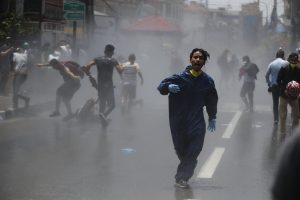At a time when a diplomatic row with India has momentarily brought together Nepal’s rival political parties, the country’s youth have been agitating for a week for a cause they say has nothing to do with politics. A series of protests that began with a sit-in demonstration outside the Prime Minister’s K.P. Sharma Oli’s residence on June 9 has since escalated into a nation-wide show of discontent.
Dissatisfied with the government’s handling of the COVID-19 response, hundreds of young people have been descending on the streets of the capital as well as major cities around the country, orchestrating peaceful protests despite the ongoing lockdown. Unlike traditional party-oriented protests, the recent demonstrations have been led by nonpartisan urban youth who have organized themselves through social media.
The government has reacted to this unexpected popular outburst by resorting to force. The protesters were met with water cannons, batons, and, in one instance, tear gas. On the third day of the protests, at least seven people were arrested. The country’s home ministry has issued a statement warning protesters that the violation of the COVID-19 lockdown would result in up to six months of imprisonment. Defying this warning, hundreds of people have continued to join the physically distanced demonstrations across the country.
Although the series of protests is not monolithic, those who participated have the same set of demands: better quarantine facilities for all, including the thousands of migrant workers heading back home, and wider PCR (or swab) tests instead of the unreliable rapid-diagnostic tests (RDTs). They have also been very critical of the state’s opacity about how taxpayers’ money has been spent in fighting COVID-19 – a concern that was particularly visible in light of Oli government’s announcement that 10 billion Nepali rupees ($82 million) had been spent so far in the COVID-19 response.
The government recently released a simple breakdown of that figure, partly in response to the protest. But as news reports of ill-maintained quarantines, viral outbreaks within these centers, and low test rates continue to emerge, many are skeptical. The protesters’ demand for a more accountable and transparent government – as seen in slogans like “Sanitize the Government” – continues.
When Nepal imposed its lockdown toward the end of March, it had only two confirmed cases of COVID-19. Three months later, that number has spiked to over 6,000, showing exponential growth in last few weeks. So far, 21 people have succumbed to the disease. Despite the head start provided by over two months of lockdown, preparations for managing the pandemic have been feeble. Quarantine centers are dangerously crowded; lack basic facilities such as clean water, nutritious food, and toilets; and offer poor medical care. The country has also been unable to institute a reliable testing regime: in several of its COVID-19-related deaths, the infection was confirmed only upon death.
Meanwhile, the government has been implicated in a number of corruption scandals, including in the procurement of unreliable and controversial RDT kits from China, which allegedly favored a private company close to the ruling party. Oli’s cavalier public comments – including the claim that Nepalis have uniquely high immunities thanks to their turmeric-rich diet – have not helped.
Such displays of negligence have alienated a section of young Nepalis. The wave of protests began with the Kathmandu middle-class youth, the “Instagen” having initiated their protests over a Facebook group named “COVID-19 Nepal: Enough Is Enough!” which has amassed nearly 200,000 members in about a week. This mobilization comes in the context of a numerically weak opposition, since the ruling Nepal Communist Party holds a two-third majority in the parliament. Despite a series of major corruption cases as well as controversial legislation, the opposition party Nepali Congress has failed to mobilize public grievances. The ongoing protests are one response to that situation.
It is also worth noting that those organizing the protests have taken great pains to articulate the “apolitical” nature of their activism. This anxiety about links to political outfits comes from a long history of party-affiliated student union protests, which have negative connotations of anarchy, partisanship, and controversy. The organizers of the protests have also been particularly guarded due to the various conspiracy theories alleging the role of foreign powers in fomenting the unrest; they fear being tagged as anti-national. In fact, on June 13 when the parliament updated the country’s political map by including borderlands disputed with India within its territory, the protesters mixed their criticism of the government with celebration of the constitutional amendment.
Such caution, however, has meant that the protests have been unable to incorporate several other dissidents, including activists pursuing justice after the murder of young Dalit men earlier this month, and grow into a larger movement. The protesters might have caught the attention of the government, but it remains to be seen if they can elicit lasting commitment from the government. As long as they insist on “apolitical” demands and avoid a larger array of political voices, the optics might overshadow the actual achievements.
Shraddha Pokharel is a researcher working on women’s political representation in Nepal, and is doing her Master of Arts in Human Rights and Democratisation at the Institute of Human Rights and Peace Studies, Mahidol University.

































